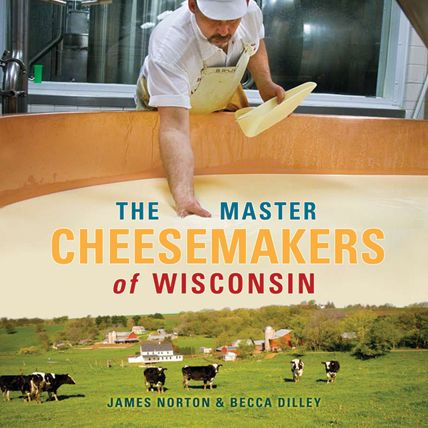The Master Cheesemakers of Wisconsin
This book—beautifully photographed and engagingly written—introduces hardworking, resourceful men and women who represent an artisanal craft that has roots in Europe but has been a Wisconsin tradition since the 1850s. Wisconsin produces more than 600 varieties of cheese, from massive wheels of cheddar and swiss to bricks of brick and limburger, to such specialties as crescenza-stracchino and juustoleipa. These masters combine tradition, technology, artistry, and years of dedicated learning—in a profession that depends on fickle, living ingredients—to create the rich tastes and beautiful presentation of their skillfully crafted products.
Certification as a Master Cheesemaker typically takes almost fifteen years. An applicant must hold a cheesemaking license for at least ten years, create one or two chosen varieties of cheese for at least five years, take more than two years of university courses, consent to constant testing of their cheese and evaluation of their plant, and pass grueling oral and written exams to be awarded the prestigious title.
James Norton and Becca Dilley interviewed these dairy artisans, listened to their stories, tasted their cheeses, and explored the plants where they work. They offer here profiles of forty-three active Master Cheesemakers of Wisconsin, as well as a glossary of cheesemaking terms, suggestions of operations that welcome visitors for tours, tasting notes and suggested food pairings, and tasty nuggets (shall we say curds?) of information on everything to do with cheese.
Winner, Best Midwest Regional Interest Book, Midwest Book Awards
1016119848
Certification as a Master Cheesemaker typically takes almost fifteen years. An applicant must hold a cheesemaking license for at least ten years, create one or two chosen varieties of cheese for at least five years, take more than two years of university courses, consent to constant testing of their cheese and evaluation of their plant, and pass grueling oral and written exams to be awarded the prestigious title.
James Norton and Becca Dilley interviewed these dairy artisans, listened to their stories, tasted their cheeses, and explored the plants where they work. They offer here profiles of forty-three active Master Cheesemakers of Wisconsin, as well as a glossary of cheesemaking terms, suggestions of operations that welcome visitors for tours, tasting notes and suggested food pairings, and tasty nuggets (shall we say curds?) of information on everything to do with cheese.
Winner, Best Midwest Regional Interest Book, Midwest Book Awards
The Master Cheesemakers of Wisconsin
This book—beautifully photographed and engagingly written—introduces hardworking, resourceful men and women who represent an artisanal craft that has roots in Europe but has been a Wisconsin tradition since the 1850s. Wisconsin produces more than 600 varieties of cheese, from massive wheels of cheddar and swiss to bricks of brick and limburger, to such specialties as crescenza-stracchino and juustoleipa. These masters combine tradition, technology, artistry, and years of dedicated learning—in a profession that depends on fickle, living ingredients—to create the rich tastes and beautiful presentation of their skillfully crafted products.
Certification as a Master Cheesemaker typically takes almost fifteen years. An applicant must hold a cheesemaking license for at least ten years, create one or two chosen varieties of cheese for at least five years, take more than two years of university courses, consent to constant testing of their cheese and evaluation of their plant, and pass grueling oral and written exams to be awarded the prestigious title.
James Norton and Becca Dilley interviewed these dairy artisans, listened to their stories, tasted their cheeses, and explored the plants where they work. They offer here profiles of forty-three active Master Cheesemakers of Wisconsin, as well as a glossary of cheesemaking terms, suggestions of operations that welcome visitors for tours, tasting notes and suggested food pairings, and tasty nuggets (shall we say curds?) of information on everything to do with cheese.
Winner, Best Midwest Regional Interest Book, Midwest Book Awards
Certification as a Master Cheesemaker typically takes almost fifteen years. An applicant must hold a cheesemaking license for at least ten years, create one or two chosen varieties of cheese for at least five years, take more than two years of university courses, consent to constant testing of their cheese and evaluation of their plant, and pass grueling oral and written exams to be awarded the prestigious title.
James Norton and Becca Dilley interviewed these dairy artisans, listened to their stories, tasted their cheeses, and explored the plants where they work. They offer here profiles of forty-three active Master Cheesemakers of Wisconsin, as well as a glossary of cheesemaking terms, suggestions of operations that welcome visitors for tours, tasting notes and suggested food pairings, and tasty nuggets (shall we say curds?) of information on everything to do with cheese.
Winner, Best Midwest Regional Interest Book, Midwest Book Awards
24.95
In Stock
5
1

The Master Cheesemakers of Wisconsin
204
The Master Cheesemakers of Wisconsin
204Paperback(1)
$24.95
24.95
In Stock

Product Details
| ISBN-13: | 9780299234348 |
|---|---|
| Publisher: | University of Wisconsin Press |
| Publication date: | 11/24/2009 |
| Edition description: | 1 |
| Pages: | 204 |
| Product dimensions: | 9.40(w) x 8.90(h) x 0.50(d) |
About the Author
From the B&N Reads Blog
